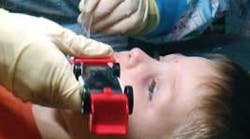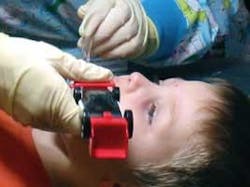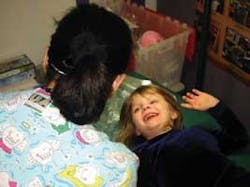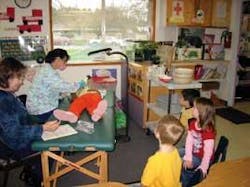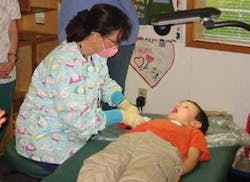by Kelli Swanson Jaecks, RDH, BSDH
Upon entering the breakroom recently I found a sticky note. Dr. H had called and wanted me to please call him back. He and I had worked together on a medical/dental van two months ago. I thought perhaps he was calling to say he enjoyed working with me and would like to do it again because of the way I gave palatal anesthesia unflinchingly, or the calm demeanor I exuded around the frightened, crying children. Not so! Dr. H was calling to ask me if I would be willing to use my LAP to see a patient of his in a nursing home. She was too ill to come to his office, but the family still requested hygiene services.
Hold it! Stop right there. What does LAP stand for you might ask? It could mean:
• Let's Advance the Profession
• Love And Peace
• Laugh At Pain
• Limited Access Permit.
Ahh, there it is — the last one. A hygienist who holds a Limited Access Permit may render dental hygiene services without the supervision of a dentist to patients or residents of facilities who, due to age, infirmity or disability, are unable to receive regular dental hygiene treatment. In other words, unsupervised, independent practice in limited access settings. This is a unique permit to the state of Oregon. All statutes and rules governing this permit come from the Oregon Board of Dentistry. A long history of incremental steps and advancement are required before a hygienist belongs to the LAP crowd (see related article). Currently, 45 out of 2,425 hygienists in Oregon hold a Limited Access Permit. Out of the 45, only about 10 are using their LAP to bring in primary income.
Why is that? One would think with the new law and door open for independent practice that hygienists would be jumping to work for themselves. Goodbye boss. Goodbye time clock. Goodbye office politics. Not so. It takes incredible energy and foresight to start up your own business, not to mention an initial and ongoing financial investment. The specific populations served are not private practice patients we generally see each day. Tough questions must be asked and answered. Who is your target population? How will you promote your services to them? How much time are you willing to put into the business? Do you need financial and/or legal counsel? Marketing and advertisement must be considered and sought out. With all of these valid concerns, however, the number one obstacle to business reported by Oregon LAP hygienists is reimbursement. Who's going to pay for the services?
At this point in time the sites available for LAP hygienists to work in are:
• Nursing homes
• Adult foster homes
• Residential care facilities
• Adult congregate living facilities
• Mental health residential programs
• Facilities for mentally ill persons
• Facilities for persons with mental retardation
• Local, state, and regional correctional facilities and juvenile detention facilities
• Students or enrollees of nursery schools and day care programs, job corps and other employment training facilities, and primary and secondary schools, including private schools and public charter schools.
Now, I'm betting some of you are asking, "Why would I want to work with that patient base?" The mentally retarded, prisoners, and nursing home residents are admittedly not the easiest patients to work with. However, others of you are seeing the wheels spin in your head about all the possibilities of independent practice and meeting the needs of these underserved populations. We are all different and have a right to our own boundaries and feelings.
That is why the LAP is not for all hygienists. Some go through the added training and requirements simply to attain the highest level of licensure in our state. Others get their LAP because they believe in the advancement of our profession and this is a huge step in the arena of autonomy and independent practice.
The bravest pioneers among us actually set up shop and use their LAP to treat the underserved. They are laying the foundation for further professional recognition and breaking down the barriers to timely, worthwhile reimbursement.
Sandy Nelson, RDH, BS, is owner and manager of her company, Smiles All Around, LLC. Zina Burt, RDH, BS, also owns her company, Preventive Dentistry. Both work primarily with the elderly in nursing homes and assisted living facilities. They love what they do but share the frustration of getting paid for services rendered. The main challenge comes from getting insurance carriers to recognize them as providers. They report that Medicaid is usually prompt with payment and supportive of treatment plans. The most consistent method of payment, however, is private sources. The patient or patient's family pays the provider directly for services rendered.
Marquita Corliss, RDH, BS, works primarily with children in local and statewide Head Start programs. She has spent untold hours setting up prevention programs and educating about dental hygiene services. Her reimbursement primarily comes from her contract with the Head Start organization, whom she bills directly. Her services consist mainly of dental hygiene exams, applying fluoride varnishes, and child prophylaxis.
All of the women use creativity and persistence to market their services and businesses. They work very hard for their patients and themselves. Satisfaction comes from knowing they are making a difference in the quality of life of their patients and providing preventive measures towards combating dental disease. Owning their own business gives them the flexibility and freedom to practice hygiene as they wish.
As Zina says about her patients, "These people are great. They are appreciative of the care I give them and I'm appreciative of the feeling of completeness they give me!"
So what was my response to Dr. H concerning his nursing home patient? He didn't need a LAP hygienist to see his own patient of record. Any of his employed hygienists could treat this patient in the nursing home under his general supervision. However, the exciting response is, "Yes, I can see your patient in the nursing home and I can treat my own patients in the nursing home, care center, preschool, and foster home!"
The doors are wide open with opportunities for the hygienist with an entrepreneurial drive and a heart for the underserved. Holding a Limited Access Permit in Oregon leads the way to professional advancement and personal fulfillment.
• Hold a valid, unrestricted Oregon dental hygiene license
• Provide evidence of at least 5,000 hours of supervised dental hygiene clinical practice during the previous five years
• Present proof of current professional liability coverage
• Current documentation of Health Care Provider BLS/CPR Training
&bulll; Completion of 40 classroom hours of course work, including but not limited to:
a. General medicine and physical diagnosis
b. Pharmacology
c. Medical emergencies and cardiopulmonary resuscitation
d. Oral pathology
e. Management and psychology of geriatric and disabled patients
f. Jurisprudence relating to unsupervised practice with limited access patients
Kelli Swanson Jaecks, RDH, BSDH, practices in a general dental office and holds a LAP permit. Kelli was a 2003 winner of Butler/RDH Healthy Gums Healthy Life Award of Distinction. She is active on both the component and state level of Oregon Dental Hygienists' Association, serving as president to her component and on the government relations council. She will be attending the ADHA National meeting as an alternate delegate this year. You can reach her at [email protected]
